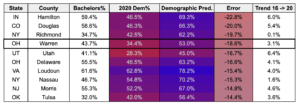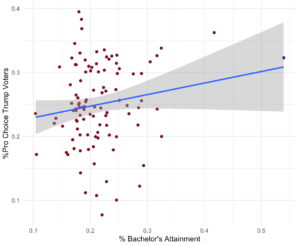Through the majority of the 2022 midterm election cycle, the Supreme Court’s decision in Dobbs v. Jackson (overturning the longstanding precedent of Roe v. Wade) has dominated headlines and analysis. Although Democrats enjoyed a strong late summer bump, ostensibly fueled by the decision, GOP candidates have substantially gained in polling completed throughout October, in the final weeks leading up to the November 8th Midterm Election. Republicans also have reasons to be optimistic about the November midterms, most notably the historical precedent of the party opposing a new president gaining congressional seats in his first midterm.
Analysts have spent a substantial amount of energy attempting to estimate the effect that Dobbs will have on the political environment this November (whether it will save Democrats from impending electoral doom) but have spent much less time considering how the Dobbs decision could drive political realignment (driving ancestral voters to switch their party of preference). Partisan realignment tends to occur first at the top of the ticket (in Presidential elections), eventually filtering down into congressional and state legislative elections. This phenomenon is generally explained by the incumbency advantage and general affinity for local representatives, who voters feel more connected to than national politicians. It explains why congressmen such as Matt Cartwright (D-PA) and Don Bacon (R-NE) were able to overperform in 2020, despite not breaking from their party on any major issues. The term coined to describe this pattern, “down-ballot lag,” is built into quantitative predictive models. Historically, analysts have determined that the best way to predict congressional results in a midterm election (2022) is a weighted average of presidential results from the past two presidential elections (2016 and 2020). This formula implies “reversion” from recent national trends, where voters will creep back from their 2020 decisions toward who they supported in 2016.
The existence of down-ballot lag has held steady for decades, but what if our assumptions about this idea break in 2022? Dobbs could cause realignment to continue in 2022 rather than voters reverting back to pre-2020 partisan preferences. The past decade has been defined by two major forms of realignment: education polarization (level of educational attainment has become more important in determining how people vote) and racial depolarization (race has become less important in determining how people vote). To illustrate how the Dobbs decision, and the increase in the salience of abortion as a whole, could drive realignment and erase down-ballot lag, let’s examine two battleground house districts with elections set to be decided on November 8th: OH-01 and TX-15.
OH-01: Incumbent Steve Chabot (R) vs. Greg Landsman (D)
OH-01 includes about half of Hamilton County and the entirety of Warren County. The district includes the entire city of Cincinnati as well as most of the wealthiest suburbs to the east and northeast of the city. The district is trending fast to the left, voting for Joe Biden by 9% in 2020 after backing Hillary Clinton by just 4% in 2016. While Cincinnati is extremely Democratic and composes nearly half the district, the wealthy suburbs and exurbs are deep red and backed Donald Trump by a large margin over Biden. Quantitative forecasters heavily favor Chabot for re-election, with FiveThirtyEight rating the race as “Likely R” and giving Chabot an 81% chance to defeat Landsman. FiveThirtyEight favors Chabot so heavily over Landsman (despite the light blue partisan lean of the district) because they assume that down-ballot lag will have his back: a Republican national environment will combine with natural tendencies for ancestral Republican voters to come back to the party and back Chabot.
Warren County is very special. Few other areas in America boast robust educational attainment numbers yet are so Republican. Composed of a mix of pink suburbs (such as Mason) and more deep red exurbs (such as Lebanon), Warren County is a true unicorn; out of the 100 highest education counties in the US with 100k or more voters in 2020, it was the second most Republican (behind heavily Mormon Utah County). Internal demographic modeling (based on race and education) expects Biden to have won ~53% of the two-party vote in Warren in 2020, but instead, he came in with a paltry ~34%. This error of ~19% ranks fourth out of all counties with 100k or more voters in 2020 (excluding the South).

These counties are predominantly wealthy, well-educated, and suburban ancestral Republican bastions. But they are rapidly shifting towards the Democratic party as educational polarization has become the chief driving force of political realignment. This is not a foreign concept, given that counties all around the country are moving closer to their demographic predictions and slowly losing their ancestral cultural biases. Ohio exemplifies this trend, as Republicans gain in low-education “Rust Belt” towns in the northern portion of the state (such as Youngstown and Lorain) while Democrats gain in the high-education suburban areas (such as in the Cincinnati and Columbus suburbs).
How will the Dobbs decision affect whether Warren County voters back Chabot in 2022? Despite the area’s historical conservatism, it is fair to assume the educated Republican voters of Warren County are likely to be disproportionately pro-choice compared to other Republican voters around America. Survey data has long shown that Republicans in well-educated, predominantly suburban areas (especially women) hold more liberal social views. And special elections this summer provided more evidence for that theory, as educated communities shifted disproportionately to the left in the months after the Dobbs decision. This August, a few months after the Dobbs decision, these suspicions were more directly confirmed at the ballot box in the Kansas Abortion Referendum as internal modeling estimates that Republican voters in higher education areas were much more like to vote “No” (pro-choice).

Given that Chabot is extremely pro-life, OH-01 could be a fertile ground for realignment to continue as ancestrally Republican and educated voters buck the GOP in light of the Dobbs decision. Although the increased salience of abortion is unlikely to save Democrats from total midterm defeat, results in OH-01 will tell us how much abortion will drive realignment and deepen educational polarization.
Note: Although Warren County only composes a third of the voters in OH-01, about another third of voters live within Hamilton County in communities like Blue Ash and Madeira, with demographic profiles resembling Warren County.
TX-15: Open Seat, Monica De La Cruz (R) vs. Michelle Vallejo (D)
TX-15 is based in the Rio Grande Valley on the Mexico border. About 75% of voters in the district live in Hidalgo County, in the rapidly growing McAllen-Edinburg-Mission metropolitan area. The district is nearly exclusively Hispanic (~80%), including a small population of white voters in Guadalupe and Wilson counties (in the San Antonio exurban area). Although longtime Democratic incumbent Vicente González won re-election by over 20% in 2018, the Hispanic revolution against Democrats caused him to defeat De Lz Cruz by less than 3% in 2020. González fled for safer turf and is running for re-election in another RGV-based seat, Biden+16 TX-34 (instead of the Trump+3 TX-15). Michelle Vallejo is a progressive who narrowly defeated more moderate opposition in the Democratic primary and, by all accounts, is an exceptionally poor fit for the RGV, which has historically been represented by Blue Dog Democrats like González and Henry Cuellar. Still, since down-ballot Democrats have traditionally been so strong in the district, FiveThirtyEight favors Vallejo slightly, giving her a 53% chance to win at the time of publication.
Democrats’ newly found weakness with Hispanic voters has been well-documented in the past two years, and TX-15 epitomizes these struggles. While Hillary Clinton carried TX-15 by 13 points in 2016, it swung 16 points to the right four years later. While Democrats enjoyed about a 7-point gain in support from college-educated white voters between 2016 and 2020 (the type of voter plentiful in Warren County), Republicans balanced this with about a 9-point gain in support from Hispanic voters.

Unfortunately for Vallejo, the Dobbs decision is unlikely to bail her out this November. Although Hispanic voters hold similar views on abortion to white voters, TX-15 voters are likely a relatively pro-life group. After controlling for party affiliation, Hispanic voters are actually much more conservative on abortion than white voters. Given that Hispanic voters in TX-15 tend to be to the right of Hispanic voters nationally, they are likely to be unswayed on the Dobbs decision and nearly evenly split on the issue of abortion.